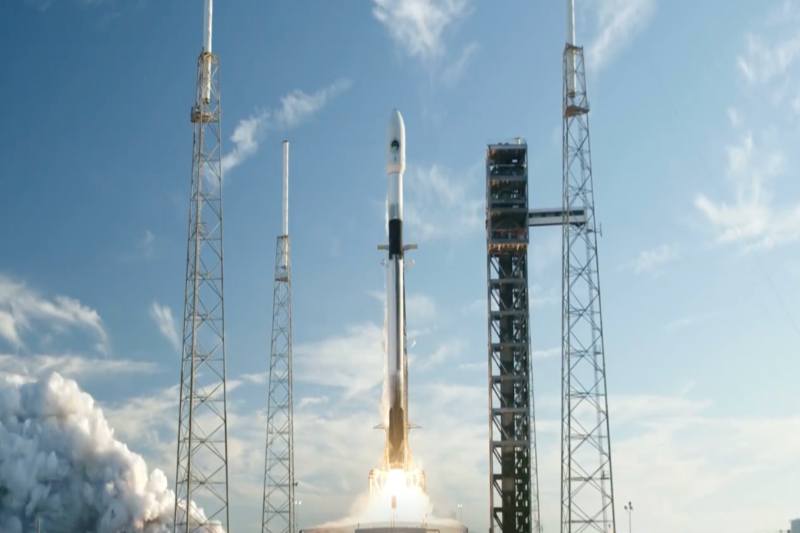Six missile-detection satellites—two for the Missile Defense Agency and four for the Space Development Agency—were launched into orbit by SpaceX on February 14 as part of a classified U.S. military operation.
USSF-124 was the mission’s name, and it took a Falcon 9 into orbit. The rocket took out from Launch Complex 40 at the Cape Canaveral Space Force Station in Florida around 5:30 p.m. Eastern.
Five L3Harris Technologies satellites and one Northrop Grumman satellite were included in the payload.
After liftoff, the upper stage and booster separated in less than two minutes. At Cape Canaveral Space Force Station, the first stage made a second landing on Landing Zone 2. At the government’s request, SpaceX terminated the broadcast following the landing and refrained from displaying any payload photos.
USSF-124 was SpaceX’s second flight under the NSSL Phase 2 contract and its eleventh mission overall under the National Security Space Launch program.
The initial prototypes for the Hypersonic and Ballistic Tracking Space Sensor (HBTSS) program of the Missile Defense Agency are two of the satellites, one from L3Harris and the other from Northrop Grumman.
Tracking Layer Tranche 0 of the Space Development Agency includes the remaining four L3Harris spacecraft. As SDA continues to assemble a sizable constellation for worldwide indications, warning, tracking, and targeting of missile threats, these demonstration satellites will supply test data.
MDA is a branch of the Defense Department. A space network named the Proliferated Warfighter Space Architecture is being constructed by SDA, an agency under the U.S. Space Force, and it consists of a transit layer and a missile-tracking sensor layer.
The two organizations are working together to create a sensor network that will allow them to track ballistic and hypersonic weapons.
USSF-124 is carrying six satellites that are destined for a low Earth orbit close to the equator. “They are all in the same plane and will work together to do demonstrations,” SDA said. “We’ll take Tranche 0 wide-field-of-view satellites and use that data to cue HBTSS satellites. That will help inform what we do in future tranches.”
“This launch represents a pivotal time for MDA as we enter a new phase of missile warning, tracking and defense,” said Lt. Gen. Heath Collins, director of MDA.
The final four satellites of Tranche 0 of SDA’s widely used satellite architecture were launched by the USSF-124 mission. 23 further Tranche 0 satellites were launched by the agency in April and December of last year.
“Launching our tracking satellites into the same orbit with the MDA HBTSS satellites is a win for both agencies,” said Derek Tournear, director of SDA. “We’ll be able to look at test targets from the same orbit at the same time, so that we can see how the two sensors work together.”
The so-called wide-field-of-view sensors on board SDA’s satellites are intended to recognize the thermal signature of a missile launch and determine if it poses a real threat.
The medium-field-of-view payloads from MDA are made to deliver the “fire control quality” data required to consistently track the missile’s location, speed, and altitude while it is in flight. Since hypersonic threats are far quicker and more nimble than conventional ballistic missiles, this precise information is essential for estimating impact sites and guiding interceptor missiles at them.
Major Event for L3Harris
Launching missile-defense satellites for two distinct programs at the same time is a major accomplishment for L3Harris, which has long aimed to establish itself as a prime contractor for military satellites in order to take on industry leaders like Lockheed Martin and Northrop Grumman.
As SpaceNews was informed by the company’s president of space systems, Kelle Wendling, “this is our first missile-defense mission with L3Harris as a prime.”
The company employed infrared imaging technology, which has been developed over decades for weather imaging and Earth research missions for organizations such as NASA and the National Oceanic and Atmospheric Administration, to construct these satellites.
“The same phenomenology can be applied to detect the heat signatures of hypersonic missiles,” said Wendling.
According to her, L3Harris now has 50 satellites in backorder, 34 of which are for SDA’s Tracking Layer Tranches 1 and 2.


